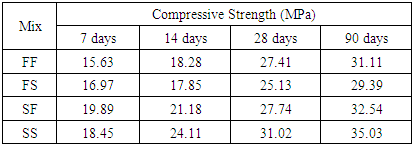-
Paper Information
- Paper Submission
-
Journal Information
- About This Journal
- Editorial Board
- Current Issue
- Archive
- Author Guidelines
- Contact Us
International Journal of Construction Engineering and Management
p-ISSN: 2326-1080 e-ISSN: 2326-1102
2024; 13(1): 1-4
doi:10.5923/j.ijcem.20241301.01
Received: Aug. 15, 2024; Accepted: Sep. 9, 2024; Published: Sep. 11, 2024

Investigating the Impact of Salt Water on Concrete's Compressive Strength
MD. Samsul Alam Dipu, Sam Anachh
Department of Civil Engineering, Mymensingh Engineering College, Mymensingh, Bangladesh (Graduate)
Correspondence to: Sam Anachh, Department of Civil Engineering, Mymensingh Engineering College, Mymensingh, Bangladesh (Graduate).
| Email: |  |
Copyright © 2024 The Author(s). Published by Scientific & Academic Publishing.
This work is licensed under the Creative Commons Attribution International License (CC BY).
http://creativecommons.org/licenses/by/4.0/

The findings and results of an experimental investigation into the impact of salt water on concrete's compressive strength are presented in this work. Both fresh and salt water were used to create the concrete cubes used in this investigation. The concrete mix originated with a water-to-cement ratio of 0.45 and an exact weight ratio of M-30 (1:1.89:2.69). Eight cubes were cast and cured in fresh water for the inquiry, whereas the remaining eight were cast and cured in salt water. In consistent weather conditions, each of these concrete blocks cured for 7, 14, 28, and 90 days, respectively. When concrete is mixed with freshwater, its average compressive strength ranges from 15.63 to 31.11 N/mm2, and when it is mixed with saltwater (35 g/l NaCl content), it ranges from 18.45 to 35.03 N/mm2.
Keywords: Compressive strength, Concrete blocks, Fresh water, Salt water
Cite this paper: MD. Samsul Alam Dipu, Sam Anachh, Investigating the Impact of Salt Water on Concrete's Compressive Strength, International Journal of Construction Engineering and Management , Vol. 13 No. 1, 2024, pp. 1-4. doi: 10.5923/j.ijcem.20241301.01.
Article Outline
1. Introduction
- In construction, concrete is an essential material, and how effectively the water is mixed is paramount. Water contaminants may have a big influence on how concrete sets, hardens, and gains strength. [1] This research examines how saltwater, often used in regions where fresh water is limited, affects the compressive strength of concrete. Water is an important component of concrete since it actively engages in the cement's chemical reaction. [2] When it comes to the preparation and development of concrete's strength, water quality is crucial. [3] Fresh water is pure and free of pollutants. Seawater has a high amount of sodium chloride. [4] Seawater is characterized by a high sodium chloride concentration. Only 2.5% of the world's water bodies are freshwater, with the rest being saltwater. [5]The additional quantities need to be taken into account when determining if the overall amount of impurities that might damage concrete is acceptable. There are several sites where one can find salt water. The primary source of these is the sea. The majority of ions found in salt water are sodium, potassium, magnesium, calcium, and chloride ions. The following salt percentages are given as the main salt components of salt water: 7.8% NaCl, 10.5% MgCl2, 5% MgSO4, 3.9% CaSO4, 2.3% K2SO4, and 0.3% KBr. [6] [7] It is evident from the facts above that sodium chloride predominates in saltwater by a wide margin. Seawater has an approximate salinity of 3.5% overall, with 78% of the dissolved solids being NaCl and 15% being MgCl2 and MgSO4. [6]The main focus of this paper is to explore the effect of water containing large quantities of sodium chlorides (like ocean water or water containing equivalent amount of sodium chloride) on concrete.
2. Materials & Methodology
2.1. Materials
- Below are specifics on the different materials that were utilized in the study:Cement: Throughout the study project, all specimens were cast using Portland Pozzolana Cement (PPC) (ASTM Type I).
|
2.2. Methodology
- Below are procedures which were followed:Mix design: Mix design followed to made concrete blocks was M30 with and exact weight ratio of (1:1.89:2.69).Material Testing: To ensure that all materials satisfy the BDS standard, properties of each and every one of them was tested in the laboratory. Like some initial testing, sieve analysis, setting time of the cement, absorption capacity test (shown in fig. 1 and 2) was carried out.
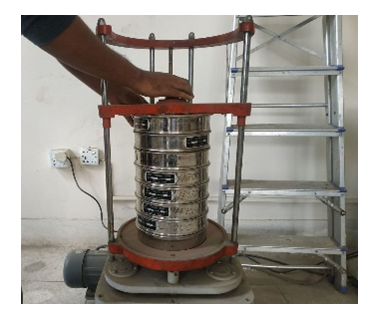 | Figure 1. Sieve Analysis |
 | Figure 2. Absorption Capacity Test |
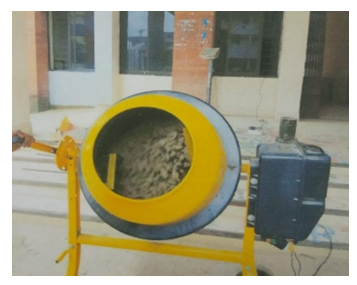 | Figure 3. Mixing |
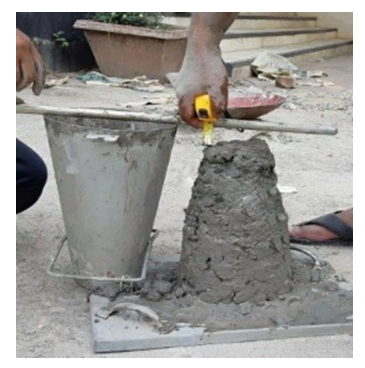 | Figure 4. Slump test |
 | Figure 5. Casting and molding |
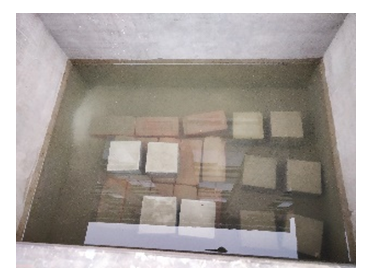 | Figure 6. Curing into Salt Water |
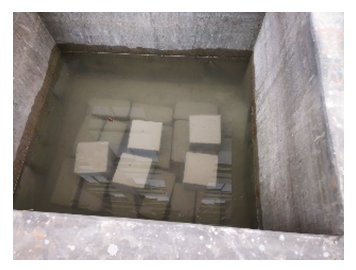 | Figure 7. Curing into Fresh Water |
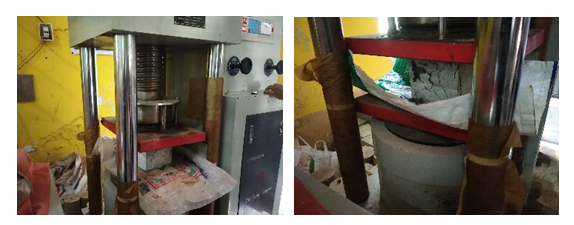 | Figure 8. Compressive Strength Testing |
3. Results
- The outcomes of compressive strength test are as follows:In Table 2 the below annotations stand for:-
|
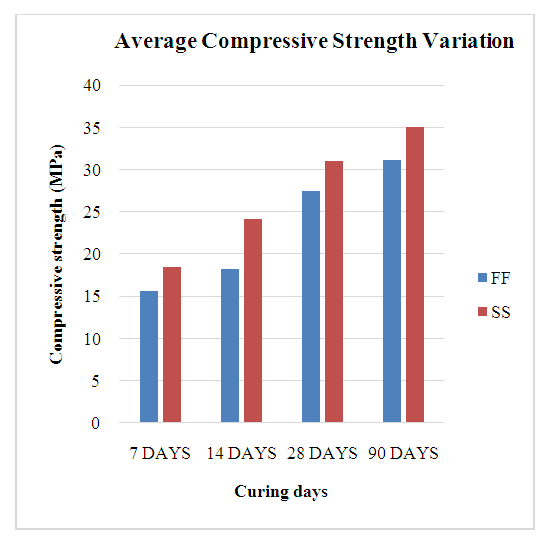 | Figure 9. Average Compressive Strength of Concrete. |
 | Figure 10. Efflorescence |
4. Discussion and Conclusions
- In this research work, the effect of salt water on the compressive strength of plain mass concrete had been investigated experimentally.The results in Table 2 and Figure 9 above show:The concrete designations SF, FS, and SS, respectively, exhibit a notable improvement in strength after 7 days, when compared to the FF control batches, which exhibit a lower strength at an earlier stage. Additionally, on the 14th day, every batch showed a rise in strength; however, the FF, SS, and SF batches showed an increase at a faster pace than the FS batches. All batches showed an increase in strength growth rate at day 28, however the SS batches' compressive strength was higher at that point than that of the control, or FF batches. Within 90 days, the batches' maximum strength was recorded, however more than 90% of that strength was already attained within 28 days.In long term efflorescence or whitish appearance of deposit salt formed on a specimen. Efflorescence in concrete can be considerable as it hampers the aesthetic appeal and potentially indicate underlying problems. Efflorescence by itself is not dangerous to the structure, but it may indicate that the concrete is too wet. More severe problems include freeze-thaw damage, corrosion of the steel reinforcement, and gradual deterioration of the concrete matrix might result from this moisture.The findings reveal that concrete cubes cast and cured in salt water exhibited a slight increase in strength, when is compared to those treated with fresh water. Compared to the cubes treated with salt water, the strength growth of the fresh water-exposed cubes was slower.
 Abstract
Abstract Reference
Reference Full-Text PDF
Full-Text PDF Full-text HTML
Full-text HTML
